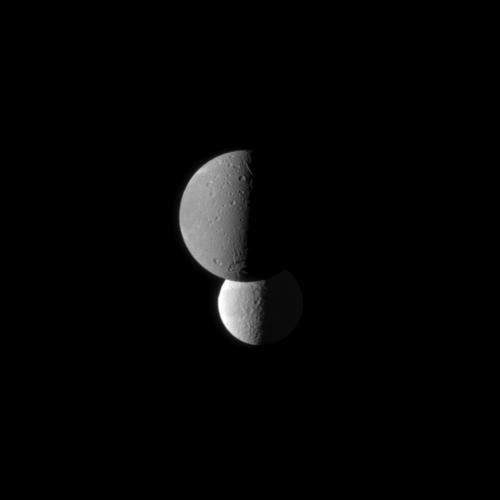Here’s this week’s Where In The Universe Challenge. You know what to do: take a look at this image and see if you can determine where in the universe this image is from; give yourself extra points if you can name the instrument responsible for the image. We’ll provide the image today, but won’t reveal the answer until tomorrow. This gives you a chance to mull over the image and provide your answer/guess in the comment section. Please, no links or extensive explanations of what you think this is — give everyone the chance to guess.
UPDATE: The answer is now posted below.
This image from the Cassini spacecraft shows Saturn’s moon Dione, in the foreground with Tethys behind.
Tethys appears brighter because it has a higher albedo than Dione, meaning Tethys reflects more sunlight. This higher albedo is due to Tethys being closer to the moon Enceladus and the E ring. Bright debris spews from Enceladus, feeding the E ring. This debris then coats Enceladus and Tethys with bright material.
See more about this image at the Cassini website.


Tethys and Dione around Saturn. Taken by Cassini
LC
PS Dione is the moon closest to the point of imaging, and Tethys is partially eclipsed.
LC
Damm, LBC, beat me to the punch! I knew Dione, wasn’t sure about Tethys, obviously Cassini. We just continue to get amazing images from this mission, love it!
Two moons of Saturn from Cassini,
now which two, that’s the mystery,…..
I was astounded to see no-one had answered this and this was featured here a earlier this year as a set of Casinni pictures.
LC
Gred and Forge.
Taken by Molly.
Saturn’s moon Dione, in the foreground, appears darker than the moon Tethys in the background.
The image was taken in visible green light with the Cassini spacecraft narrow-angle camera on March 23, 2010.
two of Saturn’s moons taken by Cassini
LBC…
You can’t get the simple things correct when you aren’t able to copy and paste the work of another.
Neither moon is being eclipsed in the picture above. Another perfect example where you know the word, but you aren’t able to use it correctly.
It’s a Cassini image of Saturn’s moons Dione (foreground) and Tethys
A remarkable image of Tethys eclipsed by Dione taken by Cassini. It may have been easy, but that’s remedied by this astonishing shot.
@Aodhhan: Give it a rest! Your ceaseless attacks on LBC are bordering on the ridiculous. What did he do to you, beat you out for a position somewhere? Your act is becoming tiresome. BTW, looks like a partial eclipse of Tethys to me, however I’m sure you have an alternative explanation.
Wow! I am surprised to see trolling on an astronomy blog.
I was to say Rhea and Dionne by Cassini but I guess I might be wrong.
Dione in the foreground and Tethys in the background, taken by the Cassini spacecraft.
William…
He hasn’t done anything to me yet… however, he has cheated many out of their work by using their words and research without giving them credit. I.e. Plagarism. I.e. acts like he’s an expert, when he really doesn’t know bumcus.
Now to hide it, he attempts to mix up the words… but in doing so, he gets it wrong, because the words don’t match, sentences don’t match, etc.
Someone who knows just about everything on all the subjects of cosmology, certainly woulnd’t misuse the science 101 nomenclature skill, “eclipse”.
An eclipse involves a body moving into the SHADOW of another body. Any apparent conjunction doesn’t always mean its an eclipse as well.
I thought an eclipse was the blocking of the light, reflected and or emitted, partially or completely, of a distant body by a foreground body, relative to an observer of course.
Sure looks to me like Casinni is observing a partial eclispe.
Sorry Aodhhan, I meant to say, as well as, “moving into the shadow of another body”.
Per Mr. Webster,
noun
1. the partial or total obscuring of one celestial body by another, esp. of the sun when the moon comes between it and the earth (called solar eclipse), or of the moon when the earth’s shadow is cast upon it (called lunar eclipse)
2. any overshadowing or cutting off of light
3. a dimming or extinction, as of fame or glory
enceladus and teythes